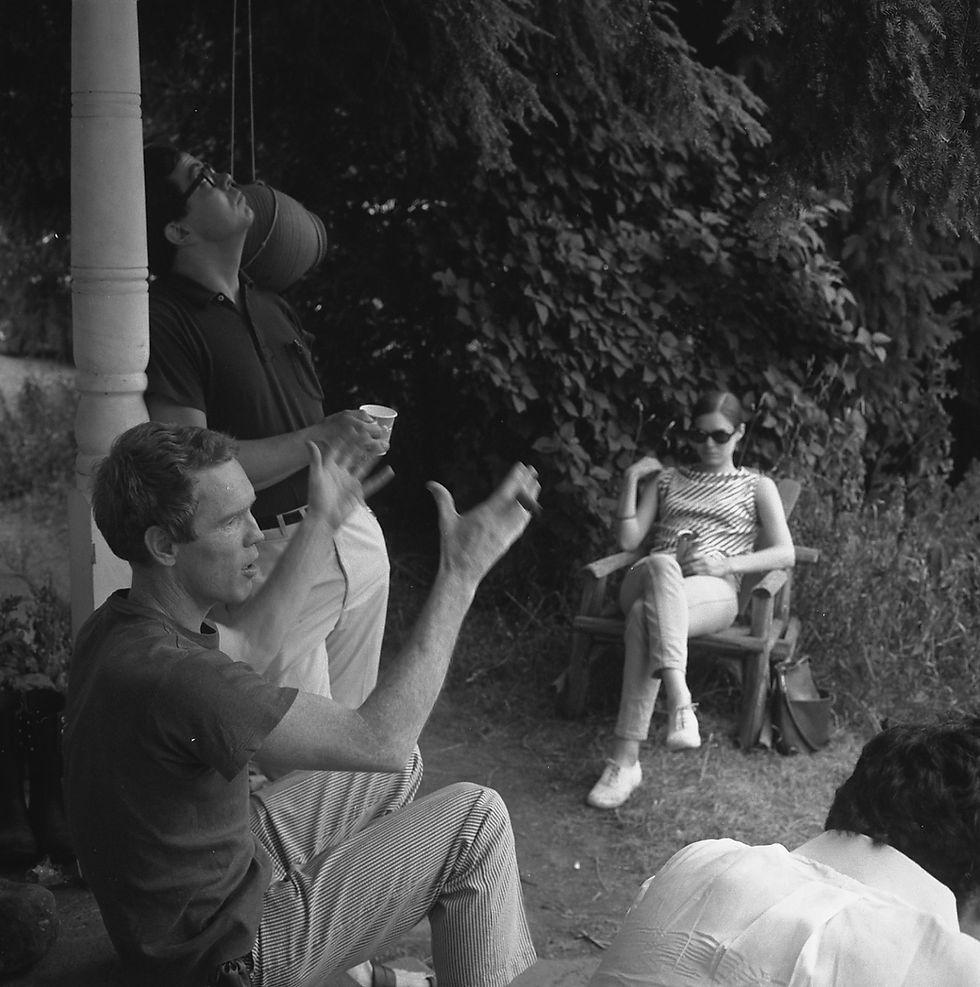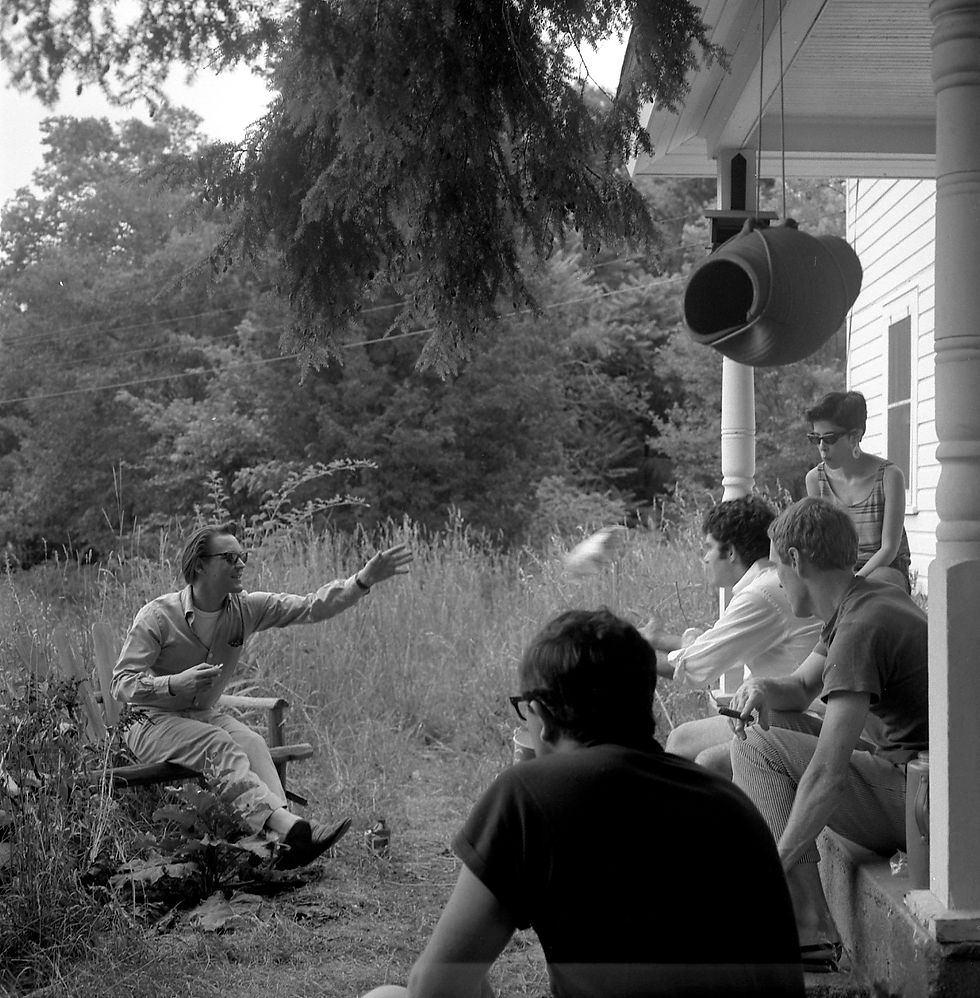On January 14, 1966, the group of artists and engineers had their first meeting at Rauschenberg’s loft. Klüver told the artists to ask for anything they wanted, and the engineers responded with suggestions on how to accomplish their ideas. These meetings lasted through March, and they collected more than seventy artists' requests. Not all of these were realized. Lucinda Childs wanted to translate her body movement into some other form of audible or visible energy. A 70 kHz Doppler sonar was successfully built, and Lucinda did have a Ground Effects Machine that moved on a cushion of air. Deborah Hay wanted to be able to stretch fabric so it became many times larger. This turned out to be impossible to do, but she did get remote-controlled moving carts. Engineer Harold Hodges found an ingenious solution for Öyvind Fahlström's request for "snowfall that falls upward.” Whitman's questions about television led to television projection being used on stage for the first time.
During the spring and summer individual engineers, worked in one-to-one collaboration with individual artists, depending on the artist’s project and engineer’s field of expertise. Other engineers worked on equipment and systems that could be used by all the artists.
As meetings between the artists and engineers progressed, the need for a flexible, wireless, networked control system for the various theatrical elements became apparent. The engineers then began to design and development what was called the Theatre Electronic Environmental Modular (TEEM) system for wireless remote control of lights, sound, video, and other effects. It was comprised of nearly three hundred components and was used in some manner in each artist’s piece. Lights and sound and other elements of the performances could be pre-programmed and activated remotely. Klüver described TEEM as the first electronic system built for onstage use and a step toward the possibility when the computer could be part of an actual performance. The TEEM began to take shape early in 1966 and was demonstrated to the artists when all the equipment was first brought together on September 10, in the gymnasium of Berkeley School near Bell Laboratories in New Jersey that the group rented for several weekends. The artists could see demonstrations of the TEEM control system, and get an idea of what it could do; and the engineers could see the results of their own work take form. Artists were able to see and work with technical equipment that had been designed and built for their specific performances: the remote controlled carts for Deborah Hay, Rauschenberg’s tennis racquets that produced sound when hit by the ball, the Ground Effects Machine for Lucinda Childs, Fahlström’s flying mylar missile. The two following two weekends, the artists and engineers continued working together trying out the equipment at the gym.
Herb Schneider took on the task of organizing an overall system of bringing together the technical and artistic aspects of each work by setting up set up a control center where the wireless control network could be centralized. Schneider held long conversations with each artist about their plans and use of elements of the TEEM system and translated these ideas into systems diagrams for each artists piece, showing the connections between the control console the equipment on stage.
The group moved into the 69th Regiment Armory on October 8th 1966, with only five days to set up before the first performance. During this time, they installed the electrical system for the stage lights and other equipment, laid miles of cable, installed the sound system with 12 speakers in the balcony surrounding the central space, and set up the bleachers for the audience. The professional rigger, Jay Bell, began to hang or rig the projection screens, swings, and other props from the ceiling. He was phenomenal, climbing up the barrel-shaped ceiling in between the beams and dropped lines down wherever needed. He climbed around the ceiling as if he were a fly. He rigged an electric hoist that came down from the middle of the ceiling, which was used by Fahlström and Whitman.
Paradoxically the switching system that was used to connect off stage elements like light sources, speakers and so on, required an enormous amount of wiring. This wiring had to be done on the spot in the Armory and the time was short. So everyone -- artists and engineers –volunteered to solder the standard mini-plugs to both ends of the wires. It was not an easy job, but the volunteers took their task very seriously and spent long hours at the wiring tables.
The artists held rehearsals as best they could. During the rehearsal time, the Armory was still used for drills by the soldiers, marching in formation among the artists and engineers.
The first two performances were held October 13, 1966.

First meeting of artists and engineers at Robert Rauschenberg's loft September 26, 1965. Left to right: Robert Whitman, unidentified, Deborah Hay, Alex Hay, Robert Rauschenberg, Manfred Schroeder, Cecil Coker, Robbie Robinson. Photo Peter Moore.

Artists' meeting in late summer at David Tudor's home in Stony Point, NY. Left to right: Robert Breer, Alex Hay, Lucinda Childs, Larry Poons' head. Photo: Franny Breer.

Left to right: Whitman , Poons, Deborah Hay, Alex Hay, Breer. Photo: Franny Breer.

First meeting of artists and engineers at Robert Rauschenberg's loft September 26, 1965. Left to right: Robert Whitman, unidentified, Deborah Hay, Alex Hay, Robert Rauschenberg, Manfred Schroeder, Cecil Coker, Robbie Robinson. Photo Peter Moore.
Artist-Engineer Meetings

9 Evenings poster



9 Evenings poster
Participating Artists and Engineers

Technical Rehearsal for 9 Evenings at Berkeley School. Irfan Camlibel on left with GEM Machine, mylar 'Missile' on right. Photo: Franny Breer

Kluver and engineers. Photo: Franny Breer

Niel Waldhauer with mylar 'missile' outside. Photo: Franny Breer

Technical Rehearsal for 9 Evenings at Berkeley School. Irfan Camlibel on left with GEM Machine, mylar 'Missile' on right. Photo: Franny Breer
Berkeley School Technical Rehearsals

Diagram of the location of bleachers and control booth in the Armory.

View of bleachers. Photo Peter Moore.

Cecil Coker and Deborah Hay looking at equipment in the control booth. Photo Peter Moore.

Diagram of the location of bleachers and control booth in the Armory.
